| Share |  |
 | |||
Health Gain - Weight Loss - Part 4 - Types of Carbs Matter
 A great deal of misinformation and confusion exists regarding what types and amounts of calories to consume to maintain a healthy weight. The popularity of “low-carb” diets and diet products in recent years has given rise to the belief that carbohydrates must be greatly reduced or even eliminated to shed those extra pounds.
A great deal of misinformation and confusion exists regarding what types and amounts of calories to consume to maintain a healthy weight. The popularity of “low-carb” diets and diet products in recent years has given rise to the belief that carbohydrates must be greatly reduced or even eliminated to shed those extra pounds.
The truth of the matter is that carbohydrates, in their whole and natural state, contain the largest amount of vitamins, minerals, anti-oxidants, fiber and unique phytonutrients (active compounds in plants that protect health and promote healing) essential for the function of a healthy metabolism and a healthy body. Counting calories is no longer necessary when you learn to eat ample amounts of whole and unprocessed carbohydrates, balanced with the right fats and lean protein.
Benefits of Carbohydrates
Of the three major classes of nutrients the body requires to function, carbohydrates are the most vital for supplying the fuel that cells need to generate energy. They are also the first nutrients to be digested, and digest more quickly than fats or protein, which makes the energy they contain more immediately available. 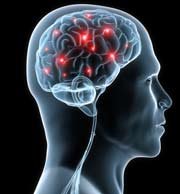 Carbohydrates are included in all the grains, vegetables, fruits, legumes, seeds and nuts derived from plants God placed on this earth for our nourishment. It is the starches and sugars within these plants that break down into glucose, a simple sugar essential to the function of every cell and organ in the body.
Carbohydrates are included in all the grains, vegetables, fruits, legumes, seeds and nuts derived from plants God placed on this earth for our nourishment. It is the starches and sugars within these plants that break down into glucose, a simple sugar essential to the function of every cell and organ in the body.
Since brain cells use twice the energy as other cells in the body, the brain is particularly dependent upon a steady supply of glucose. This is especially important because brain cells are unable to store glucose. Without sufficient carbohydrate intake to feed neurotransmitters (chemical substances that relay important information from one brain cell to another), functions such as mood, appetite, thoughts and even behavior can be adversely affected. 
According to research, low carb diets reduce levels of serotonin, the neurotransmitter responsible for elevating and calming mood. A deficit of serotonin especially affects women, because they already produce less of it than men. Optimal serotonin levels help a person feel, think and sleep better and experience fewer cravings that lead to weight gain.
Powerful Phytonutrients
In addition to supplying energy for life, powerful nutrients in whole, unrefined, unprocessed plant foods boost and balance metabolic functions and are highly beneficial to natural weight loss. They also play a significant role in preventing and reversing many degenerative diseases. The same chemicals that God enabled plants to make in order to resist disease help to protect to our bodies from disease as we consume them. The health benefits of many of these phytonutrients continue to be studied by organizations such as the National Institute of Cancer and research universities worldwide. Here is a sampling of these phytonutrients, a few of the foods that contain them, and the health benefits they deliver:
- Anthocyanidins – contained in blueberries and grapes – protect cells from free radical damage; inhibit deterioration of collagen in cartilage and blood vessels; have 50 times the anti-oxidant activity of vitamin C and E combined
- Isoflavones – found in soy, red clover, flax and rye – have ability to protect against hormone-dependent cancers
- Lycopene – found in tomatoes and ruby red
 grapefruit – helps prevent build-up of unhealthy LDL cholesterol, shown to reduce some types of cancer, especially prostate cancer
grapefruit – helps prevent build-up of unhealthy LDL cholesterol, shown to reduce some types of cancer, especially prostate cancer - Coumarins – found in parsley, licorice and citrus fruits – act as natural blood thinners
- Allylic sulfides – found in garlic and onions – strengthen immunity; defend against bacterial and viral diseases; lower blood pressure, triglyceride and cholesterol levels
- Lutein – found in spinach, collards, and other dark, leafy greens – helps reduce eye disease, such as cataracts and macular degeneration
- Beta carotene – found in carrots, pumpkin and orange sweet potatoes – precursor to vitamin A that helps with maintenance of healthy mucus membranes and eyes; improves immune system function; reduces risk of heart disease and cancer
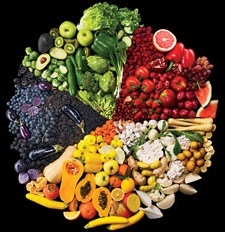 To reap the benefits of these and other powerful phytonutrients is a great reason to eat a varied diet that contains large amounts of fruits, vegetables, whole grains and legumes. Who doesn’t enjoy seeing a colorful display of beautiful fruits and vegetables? Just remember that the vibrant colors are what give fruits and veggies their nutritional power - the deeper the natural color, the higher the concentration of their phytonutrients. Eating foods of many colors (referred to by some as “eating the rainbow”) is a sure path to a nutritious diet that naturally maintains a healthy weight.
To reap the benefits of these and other powerful phytonutrients is a great reason to eat a varied diet that contains large amounts of fruits, vegetables, whole grains and legumes. Who doesn’t enjoy seeing a colorful display of beautiful fruits and vegetables? Just remember that the vibrant colors are what give fruits and veggies their nutritional power - the deeper the natural color, the higher the concentration of their phytonutrients. Eating foods of many colors (referred to by some as “eating the rainbow”) is a sure path to a nutritious diet that naturally maintains a healthy weight.
Unfortunately, the types of carbohydrates people typically eat today are the processed and highly refined empty carbs with little color and little nutrient benefit. The average American diet is loaded with sugar and products made from refined bleached flour (breads, cookies, cakes, donuts, pizza dough, crackers, pasta, etc.) Even refined carbohydrates that are not sweet quickly break down into simple sugars once inside the digestive tract.  Not only do these devitalized foods fail to give the body what it needs for health, but they also tax the digestive and elimination processes and sap the body of energy and vitality.
Not only do these devitalized foods fail to give the body what it needs for health, but they also tax the digestive and elimination processes and sap the body of energy and vitality.
Spiking Insulin – a Chain Reaction
When foods are eaten that contain carbohydrates, the body breaks them down and converts them into glucose. The presence of glucose in the blood stimulates cells in the pancreas to produce insulin, 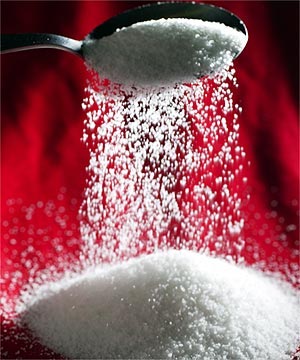 a hormone which assists the absorption of glucose into the cells, where it is used for energy. Insulin also regulates the storage of fat and glycogen (the body’s main fuel that is stored in the liver and muscle cells for later use).
a hormone which assists the absorption of glucose into the cells, where it is used for energy. Insulin also regulates the storage of fat and glycogen (the body’s main fuel that is stored in the liver and muscle cells for later use).
The more sugar in the bloodstream at one time, the more insulin is produced quickly. This rapid production of insulin is called a “spike,” and sets off a chain reaction involving a progression of scenarios, all of which program the body for weight gain and disease.
- Insulin spike caused by excess carbs shuts off fat burning and causes sugars to be stored
- Excessive amounts of insulin production by pancreas causes blood sugar to fall too rapidly
- Low blood sugar levels produce symptoms such as light-headedness, irritability, headache, sluggishness, brain fog, shakiness and hunger (brain detects falling blood sugar and sends out hunger signals)
- Individual responds to body’s cravings for sugar and refined carbohydrates by consuming more in an effort to balance out the insulin levels. This causes the pancreas to produce more insulin, which starts the cycle all over again
- Over time, more and more insulin is needed to do the same job, because the body becomes resistant to and no longer responds normally to it (just as a person addicted to a drug develops a tolerance for it that requires taking more and more of the drug to produce the same effect)

- When the cells of the body becomes resistant to insulin (condition known as insulin resistance), it cannot do the job of escorting glucose into the cell
- When glucose cannot enter the cells due to insulin resistance, too much of it floods the bloodstream at one time
- Excess glucose in the blood is sent to the muscles and liver to be stored as glycogen. When these limited stores are filled, any extra glucose accumulates as fat around the liver, in the adipose tissue around the waistline and in the blood (in the form of triglycerides)
- Stored fat is not easily released from the body, even with exercise
- Fat created by storage of excess glucose slows down metabolism, impeding a person’s ability to lose weight
- Long term insulin resistance leads to elevated triglycerides and cholesterol and diseases such as Type II diabetes, heart disease, cancer and dementia
Moral of the story? To control your weight AND preserve your health – control your blood sugar levels!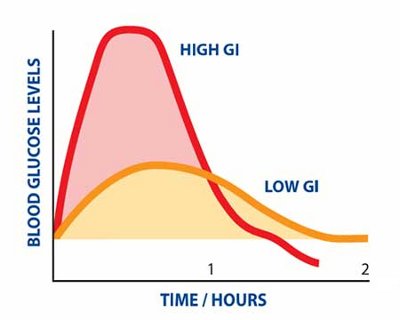 Measuring Carbohydrate’s Effects on Blood Sugar Levels
Measuring Carbohydrate’s Effects on Blood Sugar Levels
Do you need to refrain from eating all carbohydrates in order to keep your blood sugar levels under control and lose weight? No, you need only be concerned about the types of carbohydrates you consume. Different types of carbs turn into sugar at different rates in the body.
The way to keep blood sugar levels stable and prevent insulin from spiking is to eat low glycemic carbs that burn more slowly and take longer to turn into sugar.
Carbohydrates traditionally have been classified as “simple” or “complex,” based on the number of molecules in the sugar. Those with one or two molecules (like sucrose, which has one molecule of glucose and one molecule of fructose) were labeled “simple” while starchy foods composed of long chains of sugars were labeled “complex” carbohydrates. Generally, complex 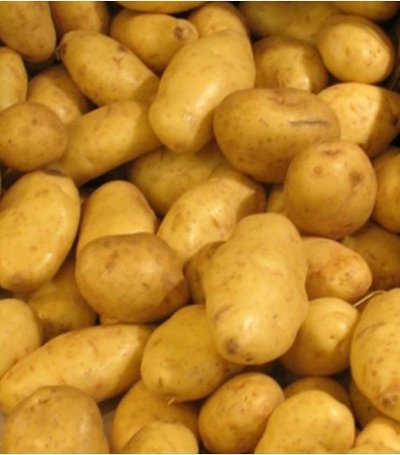 carbohydrates would lead to less increase in blood glucose than simple carbohydrates, which are more sugary foods. As scientists learned more about the differences in how various complex carbohydrates affected blood glucose response, the Glycemic Index scale came into being.
carbohydrates would lead to less increase in blood glucose than simple carbohydrates, which are more sugary foods. As scientists learned more about the differences in how various complex carbohydrates affected blood glucose response, the Glycemic Index scale came into being.
The Glycemic Index (“GI”) is a numerical system that ranks foods on how much they trigger a rise in blood sugar levels. The higher the number, the greater the blood sugar response. Any carbohydrate with a Glycemic Index number of 70 or over is considered “high glycemic.” Foods containing carbohydrates that digest more slowly have a lower Glycemic Index value. Food with a Glycemic Index number of 55 or less is considered “low glycemic.” With this system, one complex carbohydrate, such as a white potato, could have a GI value of 85 and be considered high glycemic and a different complex carb (such as brown rice) could have a GI value of 52, and be considered low glycemic.
Getting the Complete Picture – the Glycemic Load
For a more complete picture of the full effect that the eating of a particular carbohydrate has on a person’s blood sugar level, it is necessary to know more than just how rapidly the carbohydrate in the food breaks down into sugar. The “Glycemic Load” (“GL”) is a system of valuation developed by scientists that more accurately accesses the true impact that the consumption of carbohydrates has on a person’s blood sugar level.
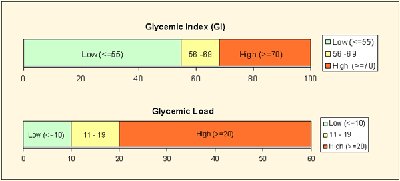
The Glycemic Index rates a food according to the speed with which a set amount of carbohydrate grams in that food raises blood sugar levels when compared with the GI standard of either glucose or white bread. The Glycemic Load, however, ranks foods according to the actual net carbohydrate content in a typical portion size. It is determined by multiplying the GI value by the quantity of net carbs (total carbohydrates minus dietary fiber) a serving contains, and then dividing that number by 100. A GL of 20, or more, is considered high, and a GL of 10, or less, is considered low.
A good example would be a watermelon. The carbohydrate in watermelon has a high GI but the GL of a portion of watermelon is low because it has little carbohydrate in it. As a general rule, however, foods with a low GI almost always have a low GL as well. 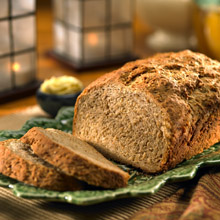 The Truth About Whole Grains
The Truth About Whole Grains
Most everyone knows that spongy white bread, or anything made with white flour for that matter, is a poor choice if you are looking for nutrients, fiber, or a low glycemic food. Many people, though, would be surprised to learn that many whole wheat breads have a similar glycemic rating, making it not much better than that spongy white bread for which we’re trying to find a healthy substitute. The reason? The flour used in products labeled “whole wheat” or “whole grain” is generally made from pulverized, rather than whole or cracked grains.
Grains in their natural state have a low Glycemic Index, because the conversion of starch to sugar occurs more slowly when digestive enzymes have to get inside the grain kernel to break down the starch contained inside. However, when the grain kernels are pulverized, the protective shells surrounding the interior starch are crushed, exposing more of the starch to our digestive enzymes as the surface area increases. This results in a quicker starch-to-sugar conversion that spikes blood sugar levels. If a “whole grain” bread can be squished in your hand and is not very grainy or chewy when eaten, it probably contains a great deal more processed flour than actual whole grains.
Choosing the Best Balance
For the purposes of controlling blood sugar levels, as well as for weight loss and general health, it is far better to rely on the GL of a food rather than to simply rely on whether or not the food has a low GI rating. According to Dr. Mark Hyman, author of Ultrametabolism, the Phytonutrient Index (PI) is an even better way to gauge which carbohydrates to eat for health and weight control. The Phytonutrient Index is a relatively new system that judges a carbohydrate on how rich it is in valuable phytonutrients. 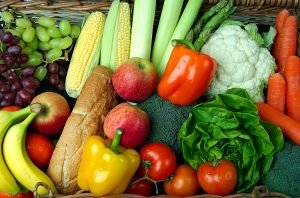 Rather than following numbers on a chart or table, the idea is to choose a variety of high quality foods – vegetables, fruits, nuts, beans, seeds, whole grains – as close to their natural state as possible. These foods are the highest in healing plant chemicals that fight disease and direct genes that control weight and metabolism.
Rather than following numbers on a chart or table, the idea is to choose a variety of high quality foods – vegetables, fruits, nuts, beans, seeds, whole grains – as close to their natural state as possible. These foods are the highest in healing plant chemicals that fight disease and direct genes that control weight and metabolism.
Choosing foods with a low Glycemic Load and a high Phytonutrient Index will do the most to control appetite and weight.
As long as you eat a diet of whole natural foods with a high Phytonutrient Index and a low Glycemic Load, you need not be concerned about your diet being too high-fat or too high-carb. Instead, be concerned that you do not let your blood sugar level get too low (by skipping meals or failing to eat a good balance of carbs, fats and protein throughout the day) or too high (by eating sugar or refined carbohydrates - especially without protein, fiber and fats to help offset the glycemic impact).
According to Dr. Mark Hyman, author of Ultrametabolism, balancing the Glycemic Load of a meal by combining phytonutrient and fiber-rich carbs with the right fats and lean protein, is the best way to ensure sugars are absorbed slowly so that insulin levels remain level. Also, by enabling the body to digest foods more slowly, it will more readily use fat for its primary fuel.
The Important Role of Fiber
One of the main reasons for focusing on eating whole carbohydrates, as close to their natural state as possible, is their high fiber content. Fiber is a calorie-free carbohydrate with countless benefits to health and weight loss, yet the average person eats only 8 to 12 grams of the 25 to 35 grams daily recommendation.
Research has revealed that people on a high fiber diet tend to weigh less, have lower cholesterol levels, lower blood pressure and a significantly reduced risk for heart disease. A Harvard study of the weight loss diets of thousands of women indicated that the risk of a heart attack was reduced by 40 percent if the diet included at least 25 grams of fiber per day.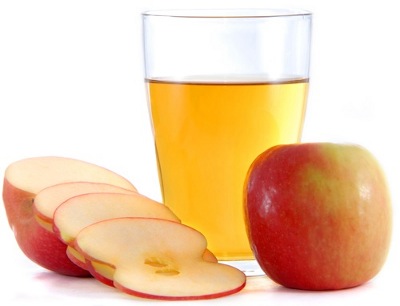 The likelihood of developing diabetes is greatly reduced when sufficient fiber is consumed, because fiber both lowers the Glycemic Load of a meal and slows the rate at which it is digested, which in turn reduces the rate and amount of glucose absorbed into the bloodstream through the small intestines. The slower absorption rate also helps to prevent obesity, since quickly absorbed glucose is more likely to turn to fat.
The likelihood of developing diabetes is greatly reduced when sufficient fiber is consumed, because fiber both lowers the Glycemic Load of a meal and slows the rate at which it is digested, which in turn reduces the rate and amount of glucose absorbed into the bloodstream through the small intestines. The slower absorption rate also helps to prevent obesity, since quickly absorbed glucose is more likely to turn to fat.
Here’s an example: when a raw apple is eaten, the fiber in the apple slows down the release of sugar because the body has to work harder to digest it. In contrast, drinking processed apple juice, from which fiber has been removed, causes the concentration of sugars in the juice to enter the bloodstream almost immediately. As another example: a carbohydrate like beans (one of the richest sources of soluble fiber) helps keep blood sugar levels steady. When fiber is stripped from a carbohydrate, though (as in the case of refined pasta), blood sugar levels rise at the same rate as if a similar amount of sugar had been consumed.
Sufficient fiber increases the transit time of digested wastes out of the body and helps prevent constipation. Anytime digested food sits in the intestines too long, intestinal bacteria can ferment and cause gas, indigestion, and bloating. Fiber also helps flush out toxins that build up in intestinal tissues, soaking up many of the fats and sugars before they are absorbed. It also acts as a “prebiotic”, meaning that it feeds and promotes the growth of “good” or “probiotic” intestinal bacteria, which keeps harmful bacteria in check.
Fiber helps weight loss in several ways. It allows a person to feel full longer on less food. Since the body has to work harder to break down fiber-filled foods, it burns off more calories. The GI and GL of a food are lowered by the presence of fiber, resulting in less absorption of sugars. Appetite is reduced since low GI and GL foods keep blood sugar levels steady and insulin spikes are avoided.
Conclusion
Rather than being an “enemy” to weight loss, carbohydrates can be your best ally in losing weight and gaining health. So load up on carbs – just make sure you load up on the right ones!!
Next month’s focus:
More health and weight loss myths revolve around the food macronutrients “fats” and “protein”. In the next couple of issues, we will explore the truth about the benefits and drawbacks of these foods, along with information on how to combine all three types of foods to promote maximum weight loss and health.
In Summary:
- Carbohydrates are beneficial plant nutrients that provide energy, a sense of well-being and powerful phytonutrients that protect against disease and turn up metabolism.
- Devitalized, processed carbohydrates raise blood sugar levels and cause insulin levels to spike, programming the body for weight gain and disease.
- Controlling blood sugar levels and keeping insulin levels steady by eating the right types of carbohydrates is the best way to control weight and preserve health.
- The Glycemic Index is an indicator of how a particular food triggers blood sugar levels, whereas the Glycemic Load gives a more complete picture of the true impact on blood sugar levels of food consumed in an actual meal.
- Choosing foods with a low Glycemic Load and a high phytonutrient content is the best combination for controlling appetite and weight.
- Fiber slows down the absorption rate of sugar into the bloodstream and has numerous other benefits that improve health and assist in weight loss.
- Avoiding refined carbohydrates and eating unprocessed, nutrient-dense carbohydrates as close to their natural form as possible will ensure healthy weight loss and a healthy body.
Sources:
- Ultrametabolism by Dr. Mark Hyman
- I Can Do This Diet by Dr. Don Colbert
- Crack the Fat Loss Code by Wendy Chant
- Master Your Metabolism by Jillian Michaels
- The 3-Hour Diet by Jorge Cruise
- www.prevention.com
- www.drwell.com
Copyright © 2008-2015 Lucinda Bedogne, CNHP, CNC
Post Your Comment...
|
|
||||||||||||


